Explore Sa Dec - South Vietnam Travel, Asia
Nestled in the heart of the Mekong Delta, Sa Dec is a charming city that often flies under the radar of mainstream tourism. With its lush landscapes, rich history, and vibrant culture, Sa Dec offers a unique and authentic Vietnamese experience. Whether you're wandering through its colorful flower gardens or exploring its French colonial architecture, this hidden gem promises a journey into the soul of Vietnam. If you're looking to escape the crowded tourist spots, Sa Dec is your perfect getaway.
Population: Approximately 100,000 in 2019.
Economy: Sa Dec’s economy thrives on agriculture, with rice, flowers, and fruit being key products. The city also benefits from tourism, local markets, and traditional crafts, supporting its vibrant economy.
Landmarks: Famous for the Sa Dec Flower Village, Huynh Thuy Le Ancient House, and Tan Quy Dong Flower Village.
Vietnam
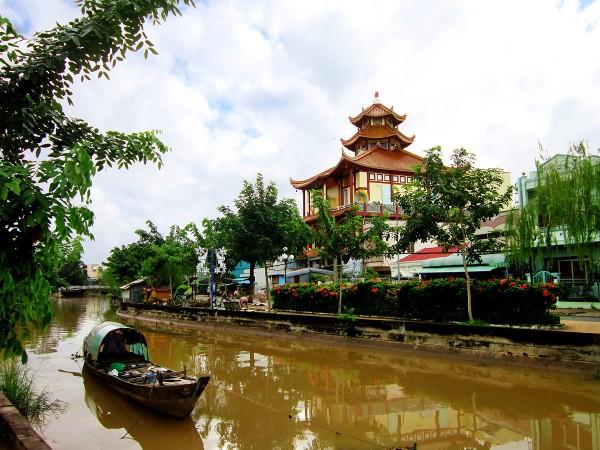
Overview of Sa Dec
History & Cultural Influence
Sa Dec’s history is a tapestry woven with threads of Vietnamese tradition, Chinese heritage, and French colonial influence. Once a bustling trading hub, the city played a significant role during the French colonial period, leaving behind an architectural legacy that still stands today. Walking through Sa Dec, you'll notice a blend of Chinese temples, French-style villas, and traditional Vietnamese homes. This unique cultural fusion is not just in its buildings but also in the daily life of its residents. The city's historical significance is also tied to its role in the famous novel "The Lover" by Marguerite Duras, which immortalized Sa Dec in world literature.
Interaction with The Locals
Sa Dec has a population of around 100,000 residents. The citizens of Sa Dec are known for their warm hospitality and strong sense of community. The city's population is a mix of ethnic Vietnamese, Chinese, and Khmer, contributing to its rich cultural diversity. The people of Sa Dec are deeply connected to their traditions, with many engaged in agriculture, particularly in the famous flower and ornamental plant industry. Despite modernization, the residents maintain a close-knit, small-city atmosphere, making visitors feel welcomed and immersed in the local culture.
Want to learn more about local culture in the south of Vietnam? Learn more about another culture-rich area, Tay Ninh, here.
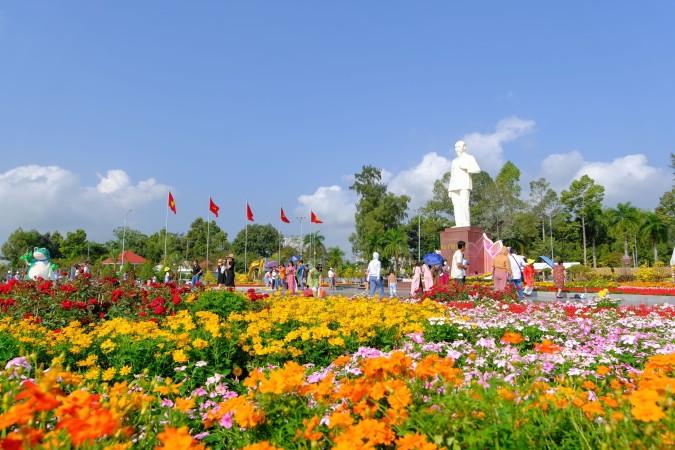
Sa Dec City, Flower Capital of Vietnam - © Nguoi Lao Dong
Top Attractions in Sa Dec
- Sa Dec Flower Village: This vibrant village is a must-visit for nature lovers. The Mekong Delta's "flower capital" is vibrant throughout the whole year. Wander through rows of blooming flowers and take in the fragrant air. The village is especially lively during the Lunar New Year when the flowers are at their peak, making it a photographer's paradise.
- Huynh Thuy Le Ancient House: Visit the Huynh Thuy Le Ancient House for a trip back in time. This well-preserved French-style mansion was the home of the lover in Marguerite Duras' novel. The house, with its ornate architecture and antique furniture, offers a glimpse into the life of a wealthy family during the colonial era. It's a must-see for history enthusiasts and fans of the novel alike.
- Kien An Cung Pagoda: A visit to this ancient pagoda is a journey into the spiritual heart of Sa Dec. Built by the local Chinese community in the early 20th century, Kien An Cung Pagoda is a beautiful example of traditional Chinese architecture. The pagoda is a place of worship and a symbol of the city's cultural diversity, making it a peaceful spot to reflect and admire intricate designs.
- Sa Dec Market: For those wanting to experience the everyday life of Sa Dec, a stroll through Sa Dec Market is essential. This bustling market is filled with fresh produce, local delicacies, and handmade goods. It’s a sensory delight where you can sample regional snacks, buy vibrant textiles, and observe the local trade in action. The market is especially lively in the morning, offering a real taste of local life.
- Tan Quy Dong Flower Village: Tan Quy Dong Flower Village, beside the larger Sa Dec Flower Village, is a must-see site for flower fans. It’s a quieter, more intimate setting where you can enjoy the beauty of various flower species and even purchase plants to take home.
Learn more about many other popular attractions in Southern Vietnam here.
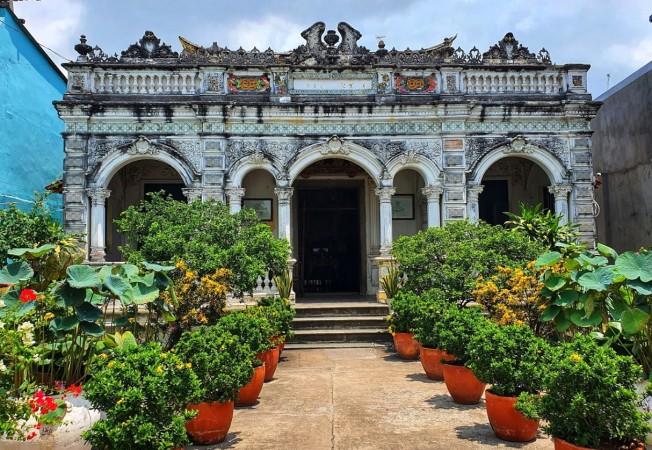
Huynh Thuy Le Ancient House - © Vietnam Tourism
Must-Try Dishes in Sa Dec
- Banh Tam Bi (Silkworm Cake): A Sa Dec classic, this dish features thick rice noodle-like cake resembling silkworms, topped with shredded pork skin, herbs, and a creamy coconut sauce. The combination of textures and flavors, along with the sweet and sour fish sauce on the side, makes it a must-try.
- Banh Xeo (Vietnamese Crispy Pancake): A crispy rice flour pancake filled with shrimp, pork, and bean sprouts, Banh Xeo is a popular dish in Sa Dec. It’s typically served with lettuce and herbs, allowing diners to wrap the pancake in greens and dip it in sweet and tangy fish sauce.
- Lau Mam (Fermented Fish Hot Pot): A distinctive and bold-flavored dish, Lau Mam is a hotpot made with fermented fish paste, offering a rich and savory broth. It’s cooked with a variety of vegetables, seafood, and meat, and is enjoyed with rice noodles. The dish is an acquired taste but beloved by locals for its deep, umami flavor.
- Goi Cuon (Fresh Spring Rolls): These light and refreshing rolls contain shrimp, pork, vermicelli noodles, and fresh herbs, all wrapped in rice paper. Goi Cuon is typically served with a peanut dipping sauce or a tangy fish sauce, making it a perfect appetizer or light meal.
- Ca Loc Nuong Trui (c): This traditional dish involves grilling a whole snakehead fish over an open flame. The fish is served with rice paper, fresh veggies, and a choice of dipping sauces. The smoky flavor of the fish, combined with the freshness of the herbs, makes it a popular dish among locals.
- Banh Phong Tom (Shrimp Chips): These crispy shrimp chips are a popular snack in Sa Dec. Made from shrimp and tapioca flour, they are deep-fried to perfection. Banh Phong Tom is often served as an appetizer or enjoyed as a light snack. You can find Banh Phong Tom in many other areas in Vietnam.
- Banh Cong (Fried Shrimp Cake): A savory cake made from ground rice, mung beans, and shrimp, Banh Cong is fried until crispy and golden. It’s served with fresh herbs and fish sauce, offering a crunchy and flavorful bite.
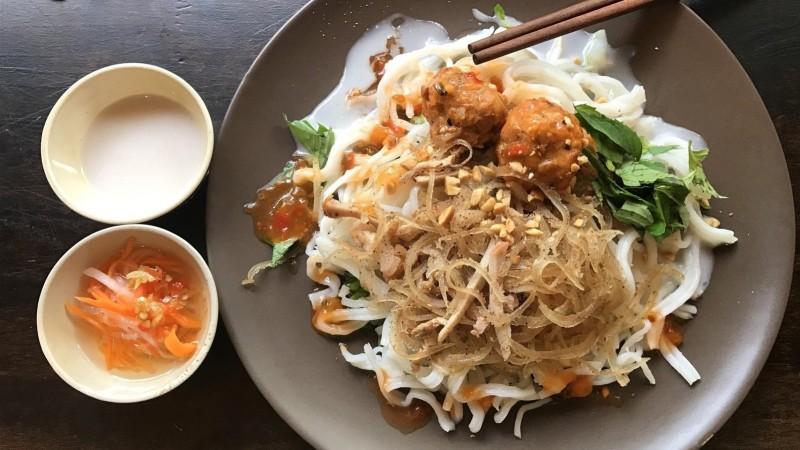
Banh Tam Bi (Silkworm Cake) - © Foody
Festivals & Local Celebrations
Sa Dec is a city rich in cultural heritage, and its festivals and local celebrations offer a vibrant insight into the traditions and customs of the region. These celebrations provide a fantastic chance for tourists to gain firsthand knowledge about the local culture.
Tet Holiday
The most significant celebration in Sa Dec, as in the rest of Vietnam, is the Lunar New Year. The city comes alive with decorations, traditional performances, and family gatherings. The Sa Dec Flower Village is especially beautiful at this season, with blossoms at their height, creating a joyous and bright environment. Visitors can enjoy traditional foods, watch lion dances, and join in the New Year’s festivities.
Thien Hau Temple Festival
Held at the Kien An Cung Pagoda, this festival honors the goddess Thien Hau, a revered figure in the local Chinese community. The festival features religious ceremonies, lion dances, and vibrant parades. It’s a unique event that showcases the cultural diversity of Sa Dec, blending Vietnamese and Chinese traditions.
Sa Dec Flower Festival
This annual event celebrates the city's famous flower industry. Held in January, the festival features flower displays, traditional music performances, and local crafts. It's a brilliant and colorful festival that emphasizes the value of floriculture to Sa Dec's economy and culture.
Discover more about tourist-friendly festivals in nearby areas here.
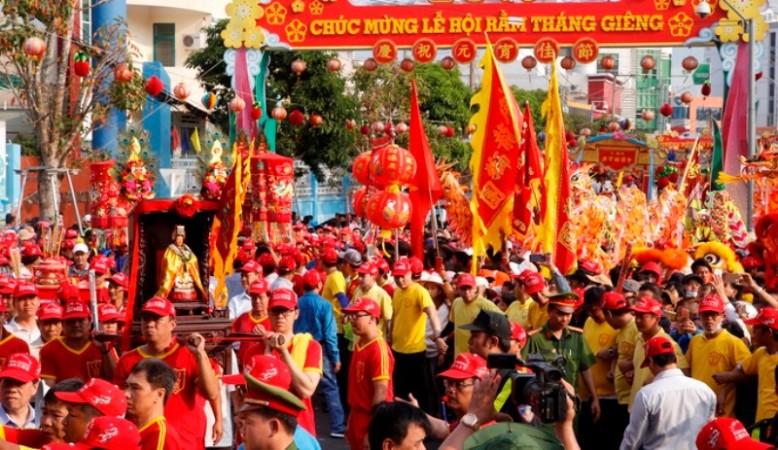
Thien Hau Temple Festival - © Suc Khoe Doi Song
What to Do in Sa Dec
Sa Dec offers a variety of activities for travelers looking to explore its natural beauty, cultural heritage, and local lifestyle. Whether you’re an adventure seeker or prefer a more relaxed pace, there’s something for everyone in this charming city.
- Mekong River Boat Tours: Exploring the Mekong River by boat is a quintessential Sa Dec experience. These tours allow visitors to navigate through the lush waterways, passing by floating markets, traditional stilt houses, and local farms. It’s an excellent way to witness the daily life of the river communities and enjoy the serene landscape of the Delta.
- Sa Dec Cycling Tours: Sa Dec’s flat terrain makes it perfect for cycling and exploring the attractions like the Sa Dec Flower Village and local markets at your own pace. Cycling offers a more intimate view of the city and its surroundings, with opportunities to stop and interact with locals along the way.
- Visiting Local Handicraft Villages: Sa Dec is known for its traditional crafts, and visiting a local handicraft village is a great way to see these skills in action. Watch artisans create pottery, weave mats, or make traditional conical hats. Some villages offer workshops where you can try your hand at these crafts, making for a memorable and interactive experience.
Shopping in Sa Dec
Shopping in Sa Dec offers a blend of traditional markets and unique local products, making it a delightful experience for visitors looking to take home a piece of this charming city.
- Sa Dec Market: This bustling market is the heart of local commerce in Sa Dec. Fresh food, spices, handcrafted products, and textiles are all available here. The market is a great area to buy mementos including traditional attire, local delicacies, and craft items. The vibrant environment and helpful merchants make shopping here an unforgettable experience.
- Flower and Plant Markets: Sa Dec is the Mekong Delta's floral hub, featuring several flower and plant markets. These marketplaces are full with vivid blossoms and unusual plants, providing visitors with a sensory thrill. While it may not be practical to take flowers home, many vendors sell seeds and small plants that can be easily transported, allowing you to bring a bit of Sa Dec’s floral beauty back with you.
- Handicraft Villages: Visiting the local handicraft villages not only provides insight into traditional crafts but also offers the opportunity to purchase unique, handmade items directly from the artisans. Whether it’s a handwoven mat, a piece of pottery, or a traditional conical hat, these items make for meaningful and authentic souvenirs.
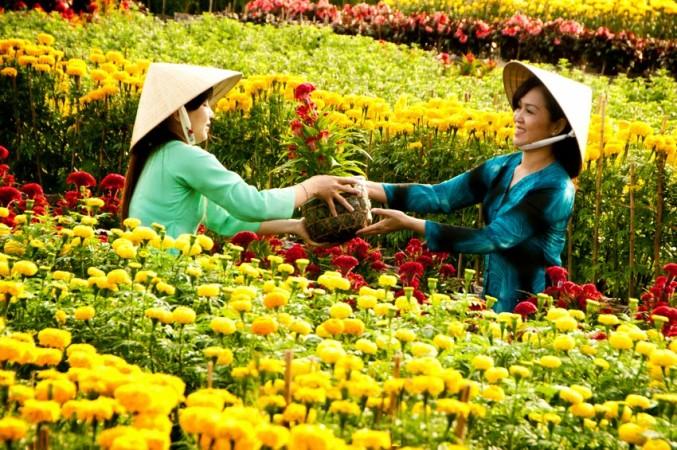
Sa Dec Market - © Vietnam Tourism
Weather in Sa Dec: Best Time to Visit
Sa Dec experiences a tropical climate typical of the Mekong Delta region, characterized by distinct wet and dry seasons.
- Dry Season in Sa Dec: The dry season in Sa Dec is marked by warm temperatures and lower humidity, making it an ideal time to visit. Daytime temperatures typically range from 25°C to 35°C (77°F to 95°F), with plenty of sunshine and minimal rainfall. This is the peak tourist season, and the weather is perfect for outdoor activities and exploring the city’s attractions.
- Wet Season in Sa Dec: During the wet season, Sa Dec experiences higher humidity and frequent rainfall. Temperatures remain warm, generally between 24°C and 33°C (75°F to 91°F). Heavy showers are common, usually occurring in the afternoon and evening. While the rain might disrupt some outdoor plans, the lush greenery and vibrant flowers during this period are particularly appealing.
Essential Travel Information
Getting Around Sa Dec
- Cyclo: A popular and leisurely way to explore Sa Dec, cyclos are ideal for short trips around the city. They offer a relaxed way to see local sights and experience the city’s atmosphere while being chauffeured by a driver.
- Motorbike: Motorbikes are a great way for people to explore Sa Dec at their own leisure. Motorbikes are commonly accessible and provide flexibility in navigating the city and surrounding areas. Make sure you have a valid license and are aware of the local traffic regulations.
- Taxis and Ride-Hailing Services: Taxis and ride-hailing services such as Grab are widely accessible in Sa Dec. They provide a comfortable and efficient way to travel longer distances or navigate unfamiliar areas.
- Boat Tours: For exploring the Mekong River and its surrounding areas, boat tours are a great option. They offer a unique perspective of the region’s landscapes and local life, with options ranging from short trips to extended excursions.
- Local Buses: While less common for tourists, local buses do operate in and around Sa Dec. They are a budget-friendly option for getting between cities or exploring nearby areas, though schedules and routes may vary.
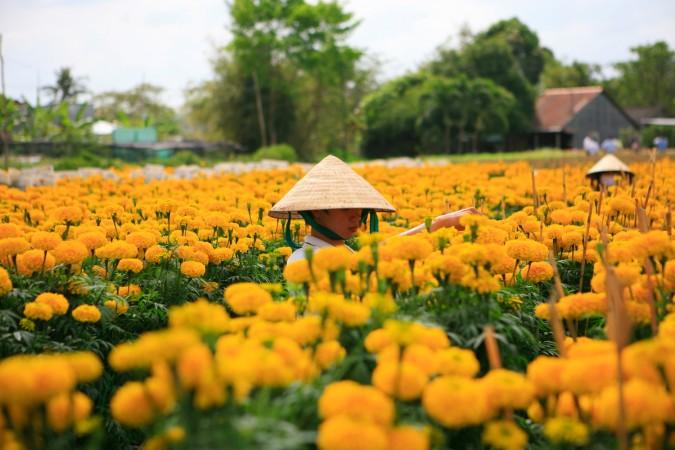
Wet Season in Sa Dec brings all the lush greenery and flowers to life - © Vietnam Tourism
ATM & Banking Services
Accessing financial services in Sa Dec is straightforward, with ATMs readily available throughout the city, especially in the center and near major markets. These ATMs accept international cards and offer services in multiple languages. While credit cards are accepted at larger hotels, restaurants, and shops, smaller vendors and markets may prefer cash, so it's advisable to carry some. Currency exchange services are offered at banks and some larger hotels, making it convenient to handle foreign currency and local cash needs.
Where to Stay in Sa Dec
Sa Dec offers a diverse range of accommodation options to suit all preferences and budgets. From budget-friendly hotels in the city center with amenities like free Wi-Fi and air conditioning, to guesthouses providing a homely atmosphere and personalized service, there’s something for everyone. For a deeper cultural experience, homestays with local families offer a unique glimpse into daily life and traditional meals. For those seeking luxury, several resorts in and around Sa Dec provide upscale amenities such as swimming pools, spa services, and fine dining, ensuring a relaxing retreat after exploring the city.
Articles for you

Explore Yala National Park - Sri Lanka Travel, Asia
Tucked away in Sri Lanka’s southeastern corner, Yala National Park is where wild nature meets deep tradition. Known worldwide for its leopard population, the park is also home to elephants, sloth bears, crocodiles, and hundreds of bird species. Beyond wildlife, Yala opens doors to a cultural landscape dotted with ancient temples, Buddhist ruins, and coastal villages. For travelers seeking more than just a safari, Yala offers a chance to explore eco-tourism, local communities, and sacred heritage sites.
Population: The Yala National Park area doesn’t have a human population.
Economy: The economy around Yala National Park thrives on a blend of eco-tourism, agriculture, and local services. Safari tours, eco-lodges, and cultural experiences drive steady income for nearby towns like Tissamaharama and Kataragama, supporting thousands of families.
Landmarks: Famous for Block I of Yala and wildlife encounters, including elephants, sloth bears, crocodiles, and exotic bird species.

Explore Galle - Sri Lanka Travel, Asia
Nestled on Sri Lanka’s southern coastline, Galle is a vibrant city where history meets the sea. Its cobbled streets, colonial architecture, and serene beaches make it a must-visit destination for travelers seeking a blend of culture, adventure, and relaxation. A UNESCO World Heritage site, Galle captivates visitors with its Dutch Fort, bustling markets, and friendly locals. Whether you’re exploring the ramparts at sunset or savoring fresh seafood by the shore, Galle promises an unforgettable journey into Sri Lanka’s heritage.
Population: Approximately 113,000 in 2023.
Economy: Galle’s economy thrives on tourism, trade, and fisheries. The city’s historic fort, colonial architecture, and coastal charm draw thousands of international visitors each year, making tourism its main economic driver. Fishing remains vital for local livelihoods, supplying fresh seafood across the region.
Landmarks: Famous for the Galle Fort, Dutch Reformed Church & Maritime Museum, and Unawatuna Beach.

Explore Bentota - Sri Lanka Travel, Asia
Nestled along Sri Lanka’s southwestern coast, Bentota is a tropical paradise that blends golden beaches, vibrant culture, and thrilling adventures. Famous for its calm waters, luxury resorts, and scenic river estuary, Bentota has become a top destination for travelers seeking both relaxation and authentic experiences. From serene beach walks at sunrise to adrenaline-pumping water sports, this coastal town offers a perfect balance of leisure and exploration. With its proximity to Colombo and Galle, Bentota is easy to reach, making it an ideal stop for both short escapes and extended holidays.
Population: Approximately 37,000 in 2023.
Economy: Bentota’s economy thrives mainly on tourism, which drives local businesses such as hotels, restaurants, and wellness retreats. The town also benefits from fishing, coconut cultivation, and handicrafts like wood carving and batik textiles. Many residents rely on the growing demand for water sports and Ayurvedic treatments, making tourism the backbone of both income and employment in the area.
Landmarks: Famous for Bentota Beach, Bentota River Safari, and Kande Vihara Temple.

Explore Mirissa - Sri Lanka Travel, Asia
Mirissa is a charming coastal town on Sri Lanka’s southern shoreline. Known for its golden beaches, turquoise waters, and vibrant marine life, it has become a must-visit stop for travelers exploring the island. Many come for whale watching, surfing, and sunset views at Coconut Tree Hill, but Mirissa offers much more than postcard beauty. The fishing boats you see anchored by the bay carry generations of stories. Local traditions, delicious cuisine, and a laid-back rhythm of life shape every visitor’s experience.
Population: Approximately 4,700 in 2023.
Economy: Mirissa’s economy is largely shaped by its coastal location. Fishing has long been the backbone of local livelihoods, with generations relying on the Indian Ocean for income. In recent decades, tourism has become the main driver of growth, thanks to whale watching, surfing, and beachside hospitality.
Landmarks: Famous for Mirissa Beach, Coconut Tree Hill, and Parrot Rock Bridge.

Explore Nuwara Eliya - Sri Lanka Travel, Asia
Tucked away in the Central Highlands of Sri Lanka, Nuwara Eliya is often called “Little England”. With its rolling tea plantations, cool misty mornings, and colonial charm, this mountain town feels like a step into another world. Travelers come here to breathe fresh air, walk through flower gardens, sip the finest Ceylon Tea, and enjoy a pace of life far from the island’s busy cities. Whether you’re drawn by scenic landscapes, heritage architecture, or the warmth of its people, Nuwara Eliya is a destination that blends nature, culture, and history in perfect harmony.
Population: Approximately 781,000 in 2023.
Economy: Nuwara Eliya’s economy thrives mainly on tea production, as it sits in the heart of Sri Lanka’s central highlands, famous worldwide for Ceylon Tea. The city also benefits from a growing tourism industry, attracting visitors with its colonial charm, cool climate, and scenic landscapes.
Landmarks: Famous for Gregory Lake, Hakgala Botanical Garden, and Victoria Park.

Explore Sukau - Malaysia Travel, Asia
Nestled on the banks of the Kinabatangan River in Sabah, Malaysian Borneo, Sukau is a destination where wildlife, culture, and conservation come together. Known as one of Asia’s top spots for river safaris and eco-tourism, this quiet village offers a front-row seat to encounters with Bornean orangutans, pygmy elephants, proboscis monkeys, and exotic birdlife.
Population: Approximately 1,400 in 2019.
Economy: Sukau’s economy is shaped by its riverine location and natural resources. Traditionally, the Orang Sungai community relied on fishing, small-scale farming, and forest gathering for their livelihood. Today, the village has shifted toward eco-tourism, with river cruises, jungle trekking, and homestays providing income.
Landmarks: Famous for the Kinabatangan River cruises, Gomantong Caves, and Ox-bow lakes and wetlands.
